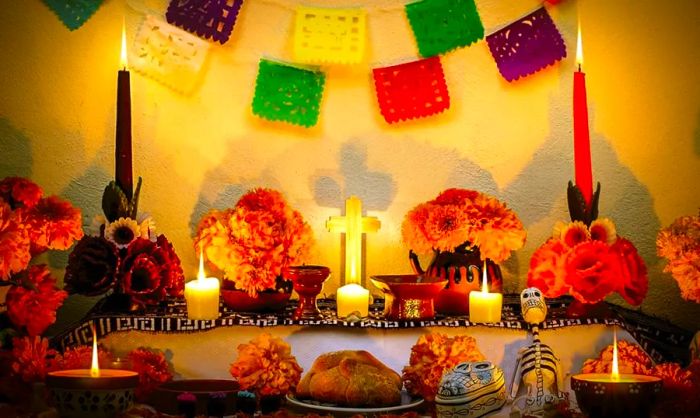Discover the Día De Los Muertos Celebrations

Uncover the origins and customs of the holiday, along with the most remarkable Day of the Dead festivities from Mexico to the U.S.!
Are you familiar with the Day of the Dead? If yes, you might have some questions about this renowned holiday, such as when it is celebrated, which countries observe it, and how?
In Spanish, it’s referred to as Día de los Muertos, a significant holiday in Mexico, where families come together to celebrate their departed loved ones with traditional Day of the Dead cuisine, lively festivities, and an abundance of marigolds–the iconic flowers of the Day of the Dead!
Films like Coco and the Book of Life illustrate the beauty of Day of the Dead for children, but are you aware of the deeper significance behind the skeleton costumes and decorations? Here’s an overview of the traditions, history, and top places to witness this vibrant celebration of life!
 Altars play a significant role in the festivities.
Altars play a significant role in the festivities.Remembering the Ancestors
Taking place across Mexico from October 31 to November 1, Día de los Muertos combines traditions and rituals from both the Americas and Europe. Its origins trace back to the Aztec civilization, meaning it essentially began 3,000 years ago in ancient Mexico!
The Aztecs held the belief that the deceased faced a challenging journey through the afterlife to reach their eternal resting place, leading them to leave food out as a way to assist them along the path. This ancient custom continues to be a part of Día De Los Muertos celebrations today.
The holiday is also shaped by European-Spanish traditions. In Spain, All Souls Day was observed by placing candles and flowers on the graves of loved ones, a practice that transitioned to Mexico.
During Día de los Muertos, it is believed that the spirits of departed loved ones can return to the living world for 24 hours to reunite with their families. Consequently, Mexicans adorn streets, homes, and cemeteries to “guide” these souls back to earth. Today, the tradition of honoring deceased relatives and friends remains central to the celebration.
 Día de los Muertos parades have only gained popularity in recent years.
Día de los Muertos parades have only gained popularity in recent years.How the Celebration Takes Place
The beautifully decorated faces and sugar skulls, known as “calaverasFirstly, altars called “ofrendas,” often decorated with icing to look like bones.
Favorite foods and beverages of the departed are included as well. Meanwhile, the living enjoy delicious tamales, candied pumpkins, and hot chocolate!
 Pan de muerto is typically infused with orange blossom or orange zest for added flavor!
Pan de muerto is typically infused with orange blossom or orange zest for added flavor!One unique custom involves crafting poems about the deceased, but don’t expect them to be sorrowful or sentimental! It’s customary to celebrate the positive aspects while playfully poking fun at the individual with humor and absurdity, keeping the atmosphere light.
Unlike common portrayals, parades have not traditionally been part of this holiday due to its family-centric nature. The ofrendas and shared meals, along with poems and stories, typically occur at home; however, parades and public festivities have emerged in recent years.
 Puerto Vallarta is an excellent place to witness the celebrations.
Puerto Vallarta is an excellent place to witness the celebrations.Where to experience it
This cherished Mexican holiday is observed throughout the nation, from the tranquil shores of Costa Maya on the southeastern coast to the elaborately adorned churches of Mazatlán in the west.
To immerse yourself in the festivities, head to Puerto Vallarta from Long Beach, California, to witness the vibrant altars adorning the boardwalk and town square, alongside lively mariachi bands and face painting contests that invite everyone to join in the celebration.
Beyond Mexico, you can find Día de los Muertos festivities in American cities with significant Mexican communities. In Los Angeles, the Hollywood Forever Cemetery hosts one of the largest celebrations outside Mexico, while in San Antonio, Texas, the iconic River Walk transforms into a Día de los Muertos wonderland with beautifully decorated barges floating along the water.
Evaluation :
5/5



